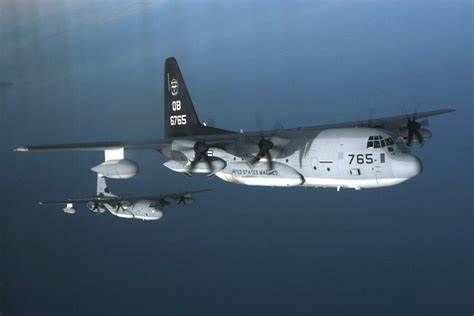
The aviation world is poised on the cusp of a new era as Lockheed Martin’s Skunk Works division unveils a rendering of a stealth tanker designed to redefine air refueling in contested airspace.

Dubbed as the prospective KC-Z, the concept art for the Next-Generation Air Refueling System program has stirred anticipation among military enthusiasts and professionals alike, signaling a transformative leap in operational capabilities for the U.S. Air Force.

The depicted aircraft, initially showcased by Aviation Week, appears to feature a prominent lambda wing design accompanied by canted twin tails.

The engines, likely numbering two, are integrated within the fuselage, with air intakes situated beneath the wing’s root, often referred to as “armpit” inlets, and possibly featuring flat nozzles at the rear.

Although the design depicted in the rendering is speculative (Lockheed Martin had released a completely different rendering last year), it’s noteworthy to observe the integration of low observability principles into high-value air assets.

Last year, the U.S. Air Force issued a request for information to the industry seeking a new tanker capable of operating in contested airspace, indicating interest in innovative solutions across various size and performance categories to meet demanding mission requirements. Subsequently, the service commenced an analysis of alternatives.

The Next-Generation Air Refueling System (NGAS) constitutes the third phase of the Air Force’s tanker recapitalization plan, following increment 1 represented by the KC-46 program and increment 2 known as KC-Y or the “bridge tanker.”

This new tanker is designed to operate in closer proximity to the frontlines, enhancing support for fighters, while more conventional tankers would maintain operations at a safer distance.

“It’s not one airplane. It’s a system, so it’s not one-size-fits-all. I’m not looking to develop a fleet that has to handle every threat environment,” stated Gen. Mike Minihan, commander of Air Mobility Command, during a previous briefing with reporters.

Gen. Minihan has outlined three distinct roles for tankers within NGAS. The majority of air refueling missions would be carried out in permissive environments by “traditional” tankers based on commercial platforms like the KC-46. Meanwhile, a second tanker, benefiting from enhanced survivability and connectivity, would operate in closer proximity to combat zones.

The final type, potentially designated as KC-Z, is slated to operate within the same operational sphere as fighter jets, particularly for high-end missions. Consequently, it necessitates a compact size and enhanced survivability.

This entails incorporating heightened self-protection measures and advanced networking capabilities beyond those found in existing models. Such enhancements are vital for countering threats posed by potential adversaries to high-value aircraft like tankers while simultaneously fulfilling its primary air refueling role.

Gen. Minihan highlighted that beyond their primary refueling role, these aircraft could encompass a broader range of capabilities. Specifically, he mentioned the potential inclusion of features such as open architecture, autonomy, and advanced battle management systems on the new tanker.

Some of these enhancements might even be integrated into operational KC-46s prior to the introduction of NGAS. However, the exact plan for the new tankers remains subject to change.

Last year, the Air Force announced intentions to procure only 75 tankers under the forthcoming “Bridge Tanker” program and accelerate the deployment of NGAS. Nevertheless, the availability of funding will play a significant role in shaping these plans, particularly given the Air Force’s concurrent commitments to major programs like the B-21 Raider and NGAD. Gen. Minihan emphasized the importance of ensuring that the new tankers are fielded “without bankrupting the Air Force.”
Relevant articles:
– Skunk Works Releases New KC-Z Stealth Tanker Rendering, The Aviationist
– Watch A KC-135 Stratotanker Fly Low Level In The Mach Loop For The First Time, The Aviationist
– Skunk Works Looks to Bridge Tanker, KC-Z, and Lighter-Than-Air, Air & Space Forces Magazine
– US Congress halts KC-135 replacement until USAF produces stealth tanker acquisition plan, FlightGlobal
